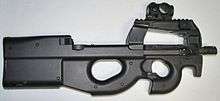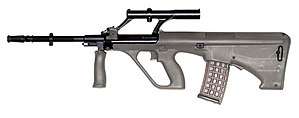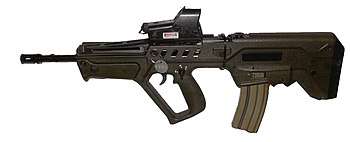Bullpup
A bullpup firearm is one with its action behind the trigger. This creates an overall more compact and maneuverable weapon in comparison to conventional firearm designs with the same length of gun barrel, and maintains advantages of a long barrel such as better muzzle velocity and accuracy while reducing the overall size and weight.
The bullpup concept was first tested in 1901 with the British-made Thorneycroft carbine, but it was not until the Cold War that more successful designs and improvements made such design successful. In the 1970s, the Austrian Army became the first military force in the world to adopt a bullpup rifle, the Steyr AUG, as a principal combat weapon. Since then the militaries in many countries have followed suit, such as Australia, China, India, Israel, France, Singapore and the United Kingdom.
Etymology
The origin of the term "bullpup" for this configuration has long been unclear. In 1957, the word was reported to denote a target pistol, particularly one with a fancy stock.[1]
British firearm expert Jonathan Ferguson researched the origin of the term in 2019-2020 and came up with early references in the 1930s implying that "bullpup" is derived from an analogy of such rifles to bulldog puppies (colloquially called "bullpups" in England during the late 19th and the early 20th century), which was considered "squat, ugly but still aggressive and powerful".[2] The original meaning of the word to describe dogs has since fallen out of use, but the term has remained within the firearm industry.
Description
The bullpup design places the gun's action behind the trigger, usually in front of a short stock.[3] The entire magazine is often also located behind the trigger group,[3] although it is only necessary for the weapon's feed location to be located there for it to be classified as a bullpup; in some designs, such as the Heckler & Koch G11 and Neostead, the magazine or magazines extend forward rather than downward.[4]

Benefits
- The primary benefit of a bullpup weapon is that the weapon's overall length can be significantly decreased without reducing the barrel length. This allows a bullpup weapon to be more easily maneuvered and concealed, especially around in tight spaces, than a conventional weapon with a similar barrel length.[5]
- In some designs, the shorter length of stock reduces the weight compared to a conventional rifle with the same action.
- The center of mass of a bullpup weapon is more posterior, thus closer to the shooter's core. This means less torque when moved around, making the handling kinetically more comfortable, especially when the shooter is running.
- Due to the shorter distance between the action and the butt plate, the recoil impulse is transmitted more directly into the shooter's shoulder, with less leverage to create muzzle rise.
Limitations
- In a bullpup weapon, the user's face is much closer to the action. This can increase noise issues, cause irritation to the shooter's eye and nose from exhaust gas, have spent bullet casings potentially ejected into the face of left-handed shooters, and renders it difficult for a right-handed shooter to "off-hand" the weapon.[3] For weapons with reciprocating charging handles, there is also the risk of their charging handles striking left-handed users. As a result, bullpups often require unusual ejection mechanisms in order to allow ambidextrous operation. This is solved on some designs with ejection downward (FN P90, Kel-Tec RDB) or forward (FN F2000,[3] Kel-Tec RFB).[6]
- In the rare case of a catastrophic failure, a bullpup weapon is more dangerous because both the barrel and the action are nearer to the shooter's head and torso.
- When using iron sights, bullpup firearms typically have shorter sight radius than conventional designs of the same barrel length, making it trickier to shoot accurately.
- Bullpup weapons need a much longer trigger-sear linkage due to the trigger's forward position, so they tend to have stiffer, less precise triggers. Trigger pull characteristics are thus a frequent criticism of bullpup weapons.[7]
- Changing magazines are often less intuitive and ergonomic, and very difficult to perform a "drop free" change. This can be particularly problematic when the weapon is equipped with a sling, whose attachment is nearer to the magazine well in bullpup weapons and can physically interfere with magazine insertions.
History

One of the earliest repeating bullpup designs was patented by William Joseph Curtis in 1866.[8] The concept was later used in bolt action rifles such as the Thorneycroft carbine of 1901, although the increased distance from hand grip to bolt handle meant the decreased length had to be weighed against the increased time required to fire. It is known to have been applied to semi-automatic firearms in 1918 (6.5 mm French Faucon-Meunier semi-automatic rifle developed by Lt. Col. Armand-Frédéric Faucon), then in 1936 a bullpup machine pistol was patented by the Frenchman Henri Delacre.[9]

After World War II, Western engineers drew inspiration from the German Sturmgewehr 44 assault rifle, which offered a compromise between bolt-action rifles and submachine guns. Among them was Kazimierz Januszewski (also known as Stefan Janson), a Polish engineer who had worked at the Polish national arsenal during the 1930s. After being mobilized during World War II he escaped German and Soviet forces and made his way to England, where he was a part of the "Polish design team" at Enfield Lock's Royal Small Arms Factory. The factory was run by lieutenant colonel Edward Kent-Lemon. As Januszewski was developing a new rifle, the "Ideal Calibre Board" was searching for a replacement for the .303 cartridge. The Board decided on an optimal 7 mm cartridge on which Januszewski and the two teams working at Enfield had to base their designs. One design team led by Stanley Thorpe produced a gas-powered rifle with a locking system based on the Sturmgewehr. The design used steel pressings which were difficult to obtain, and the design was scrapped. The result of the Polish design team's efforts was the EM-2, which broke significant new ground.[10]
The EM-2 contained some similarities to the Soviet AK-47, although Januszewski had never seen the Soviet rifle. The first significant bullpup assault rifle came from the British programme to replace the service pistols, sub-machine guns, and rifles. In the two forms of the EM-1 and the EM-2, the new rifle concept was born as a result of the experience with small arms that was gained during the Second World War.[10]
It was obvious that the modern warfare would require the infantry to be armed with a light, selective fire weapon, with effective range of fire much longer than that of a submachine gun, but shorter than that of conventional semi-automatic or bolt action rifles. The bullpup design was seen as a necessity to retain the accuracy at range while reducing overall length. The EM-2 was adopted by the UK in 1951 as the world's first (limited) service bullpup rifle, but was promptly displaced by the adoption of the 7.62×51mm NATO (0.308 in) cartridge, to which the EM-2 was not easily adapted. The decision was rescinded and a variant of the more conventional FN FAL was adopted in its place.[11]
A 7.62×39mm M43 calibre experimental assault rifle was developed by German A. Korobov in the Soviet Union around 1945, and a further development, the TKB-408 was entered for the 1946–47 assault rifle trials by the Soviet Army, although it was rejected in favour of the more conventional AK-47. The United States briefly experimented in the same year with the integrally-scoped Model 45A bullpup, which never progressed beyond the prototype stage; John Garand designed his T31 bullpup, abandoned after his retirement in 1953.
After these failures of the bullpup design to achieve widespread service, the concept continued to be explored (for example: a second Korobov bullpup, the TKB-022PM).
Adoption


_MOD_45160295.jpg)


The Steyr AUG (selected in 1977) is often cited as the first successful bullpup,[12][13][14] being in service with the armed forces of over twenty countries, and becoming the primary rifle of Austria and Australia. It was highly advanced for the 1970s, combining in the same weapon the bullpup configuration, a polymer housing, dual vertical grips, an optical sight as standard, and a modular design. Highly reliable, light, and accurate, the Steyr AUG showed clearly the potential of the bullpup layout. The arrival of the FAMAS in 1978, and its adoption by France emphasized the slide from traditional to bullpup layouts within gun designs.[14]
The British resumed their bullpup experiments with the L85, which entered service in 1985. Following persistent reliability problems, it was redesigned by the then British-owned Heckler & Koch into the L85A2, to become a fully reliable weapon.[15] As of 2016, it is being replaced with the L85A3 which is lighter, more adaptable, and more durable.
Having learned from extensive combat experience, Israel Military Industries developed a bullpup rifle: the Tavor TAR-21. The Tavor is light, accurate, fully ambidextrous and reliable (designed to stringent reliability standards to avoid malfunctioning in desert conditions), and is in increasing demand in other countries, notably India.[3] The Tavor shares many similarities with the SAR 21 and the South African Vektor CR-21.[3] The Islamic Republic of Iran Army has adopted the KH-2002 and the Chinese People's Liberation Army use the QBZ-95.[16]
Some sniper rifles such as the American Barrett M95 and XM500,[17] German Walther WA 2000 and DSR-1,[18] Chinese QBU-88, Russian SVU, Polish Bor, American Desert Tech SRS and American Desert Tech HTI[19] use the bullpup layout. It is also used for combat shotgun designs such as the Neostead and Kel-Tec KSG.[20]
Bullpups adopted for current standard issue by various armed forces:

.svg.png)











.svg.png)









See also
- Close quarters combat
- List of bullpup firearms
- Personal defense weapon
References
- Dalzell, Tom; Victor, Terry (27 November 2014). The Concise New Partridge Dictionary of Slang and Unconventional English. Routledge. p. 119. ISBN 978-1-317-62512-4.
- https://www.youtube.com/watch?v=fTWC_EzHMBw
- Dockery, Kevin (2007). Future Weapons. Berkley Caliber. p. 64, 93-95. ISBN 978-0-425-21750-4.
- Cutshaw, Charles Q. (28 February 2011). Tactical Small Arms of the 21st Century: A Complete Guide to Small Arms From Around the World. Iola, Wisconsin: Gun Digest Books. pp. 338–339. ISBN 1-4402-2709-8.
- Tilstra, Russell C. (21 March 2014). The Battle Rifle: Development and Use Since World War II. McFarland. p. 18. ISBN 978-0-7864-7321-2.
- Sweeney, Patrick (25 February 2011). "Kel Tec RFB". Gun Digest Book of The Tactical Rifle: A User's Guide. Iola, Wisconsin: Krause Publications. pp. 73–75. ISBN 1-4402-1892-7.
- Sweeney, Patrick (10 May 2004). Modern Law Enforcement Weapons & Tactics. Iola, Wisconsin: Krause Publications. p. 189. ISBN 1-4402-2684-9.
- https://www.youtube.com/watch?v=HcIG5OqQjlw
- Dugelby, Thomas B. (1984). Modern Military Bullpup Rifles: The EM-2 Concept Comes of Age. Collector Grade. pp. 21–47. ISBN 978-0-88935-026-7.
- Dugelby, Thomas B. (1980). EM-2: Concept and Design. Toronto: Collector Grade Publications. pp. 258–260. ISBN 978-0-88935-002-1.
- Cashner, Bob (20 August 2013). The FN FAL Battle Rifle. Bloomsbury Publishing. p. 12. ISBN 978-1-78096-904-6.
- Cunningham, Grant (1 October 2015). "The Bullpup Rifle Experiment, Part 4: do they have a place in the home defense arsenal?".
- Crossley, Alex (1 September 2013). "Gun Review: The VLTOR AUG A3".
- Lewis, Jack (28 February 2011). Assault Weapons. Iola, Wisconsin: Gun Digest Books. p. 51. ISBN 1-4402-2400-5.
- Hogg, Ian (1 June 2003). Handguns & Rifles: The Finest Weapons from Around the World. Globe Pequot Press. p. 36. ISBN 978-1-58574-835-8.
- Lai, Benjamin (14 July 2016). The Dragon's Teeth: The Chinese People’s Liberation Army—Its History, Traditions, and Air Sea and Land Capability in the 21st Century. Casemate. p. 220. ISBN 978-1-61200-389-4.
- McNab, Chris (24 March 2016). The Barrett Rifle: Sniping and anti-materiel rifles in the War on Terror. Bloomsbury Publishing. pp. 16–19. ISBN 978-1-4728-1102-8.
- Dougherty, Martin J. (16 October 2012). SAS and Elite Forces Guide Sniper: Sniping Skills from the World's Elite Forces. Lyons Press. p. 92. ISBN 978-0-7627-8876-7.
- https://deserttech.com/timeline.php
- Mann, Richard Allen; Lee, Jerry (20 November 2013). The Gun Digest Book of Modern Gun Values: The Shooter's Guide to Guns 1900–Present. Iola, Wisconsin: F+W Media. p. 576. ISBN 978-1-4402-3752-2.
- https://deserttech.com/timeline.php
- https://deserttech.com/timeline.php
- https://deserttech.com/timeline.php
- https://deserttech.com/timeline.php
- https://deserttech.com/timeline.php
- https://deserttech.com/timeline.php
- Pauly, Roger (2004). Firearms: The Life Story of a Technology. Greenwood Publishing Group. ISBN 0-313-32796-3.
- Westwood, David (2005). Rifles: An Illustrated History of Their Impact. ABC-CLIO. ISBN 1-85109-401-6.




